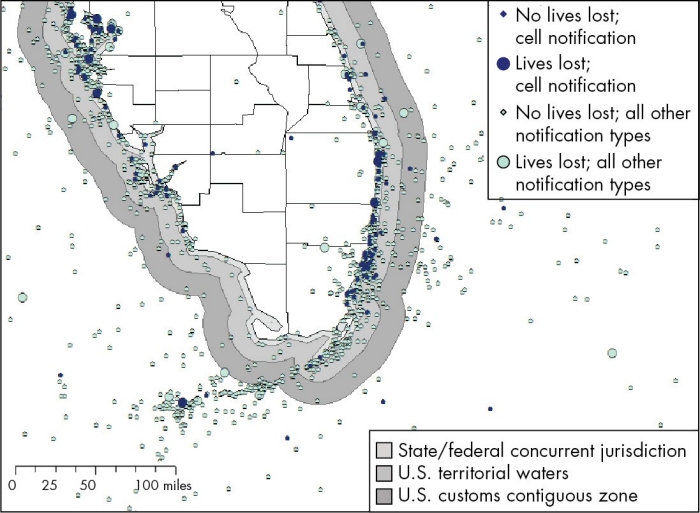by Douglas Yeung
Source Link
A growing proportion of maritime distress calls to the Coast Guard comes indirectly through social media, 911, or cell phones, but these mechanisms can lack the location data that the Coast Guard needs to quickly determine a mariner’s position and render emergency assistance.
Source Link
A growing proportion of maritime distress calls to the Coast Guard comes indirectly through social media, 911, or cell phones, but these mechanisms can lack the location data that the Coast Guard needs to quickly determine a mariner’s position and render emergency assistance.
The Coast Guard lacks the organizational capacity to collect and analyze the volume of social media data that could provide location information or other context when it is responding to emergencies.
Organizations responding to disasters and other emergencies need to know rapidly how to locate affected areas and individuals and to allocate response resources accordingly. Given this, situational awareness is crucial for effective disaster response operations. In the modern communication environment, cell phones and social media can offer valuable information in emergency response operations, such as search and rescue and disaster relief.
Yet effectively using these media for situational awareness remains challenging. For the Coast Guard, using response teams to monitor social media feeds can be labor-intensive, and the sheer volume of social media posts hampers seeing all the relevant information. Furthermore, large amounts of data can be gathered from social media, which then must be organized, processed, and frequently integrated with data from other sources, such as environmental sensors or satellite data. Organizations in charge of disaster response might lack mechanisms to process and integrate large amounts of data effectively. In addition, calls from cell phones often lack location information that would help responders target rescue or other response efforts.
Purpose of the Homeland Security Operational Analysis Center Study
Better understanding of the social media and cell phone environments could help inform future U.S. Department of Homeland Security (DHS) policy on using these media in response operations. To advance understanding of this issue, Homeland Security Operational Analysis Center (HSOAC) researchers conducted a study to help DHS understand how social media and cell phone data might be better leveraged to improve situational awareness during response operations. The research focused on response operations of the U.S. Coast Guard.
Findings
Using several types of analyses, the HSOAC team found that the use of social media to place distress calls in disasters and other emergencies is growing. During several hurricanes in 2017, for example, social media were, in some instances, the only way for survivors to request assistance. The Coast Guard established a call center based in Washington, D.C., to monitor tagged social media requests. Requests that arrived via social media and by phone were triaged by urgency of need and validated, when possible, before being routed to operations centers in Texas. The Coast Guard, although it requested that people call 911 instead of posting on social media, also set up impromptu capabilities to handle social media calls for help.
For decades, the Coast Guard has monitored communication channels on radio frequencies for distress calls from boaters. These calls provide location information that can be used to find mariners in distress. But a growing proportion of maritime distress calls from boaters come to the Coast Guard through cell phones, indirectly from 911 calls, or through social media. These channels might lack location information, and the Coast Guard has limited awareness of overwater cell phone coverage. The authors also found that deaths occur disproportionately in the area closest to shore. In light of the fact that boaters are using their cell phones to call for aid, enhancing the Coast Guard’s ability to use this method of communication to locate boaters could provide opportunities to reduce fatalities. (The figure shows search-and-rescue cases along Florida's coast in 2018 by notification type and by fatality status.)
Fatalities and Modes of Calling for Help

SOURCE: Marine Information for Safety and Law Enforcement (MISLE) data.
Finally, the Coast Guard does not possess the organizational capacity to collect and analyze social media information that could be helpful in responding to emergencies. This shortfall includes both computing capacity—such as a way to aggregate and analyze imagery patterns during a crisis—and human capacity to process the information.
Recommendations
To address these issues, the HSOAC team recommended the following steps:
DHS should develop policies and procedures to facilitate sharing cell phone location data with the Coast Guard. Enabling the public to share Global Positioning System locations from cell phones when in distress could help with this. Several location-sharing options could help—a messaging app, a mapping app, a dedicated app, and a web browser.
The Coast Guard should work to ensure that some organization—either itself or another—assumes responsibility for understanding cell coverage over water. The Coast Guard currently has no responsibility for or insight into cellular coverage. As a result, the Coast Guard lacks reliable information about cellular coverage over bodies of water, either to inform its own missions or to share with mariners. The Coast Guard could seek to collect coverage information by conducting tests of cell phone signals at different distances from shore by deployed assets and should also consider advocating that it or another organization be responsible for maintaining oversight of cellular coverage over water.
The Coast Guard should identify other missions in which social media information could help to increase maritime safety and security and enhance environmental protection and response operations. Although the primary focus of this research was the Coast Guard’s response operations, the findings and recommendations could enhance other Coast Guard missions, such as prevention-oriented missions. For example, social media capabilities could also be useful to support marine casualty investigations and civil investigations relating to this regulatory mission, which the Coast Guard considers a prevention mission rather than response operations. Passive monitoring of social media activity could also help the Coast Guard gain awareness of events affecting maritime safety or security (e.g., protests, facility strikes, large marine events).
No comments:
Post a Comment